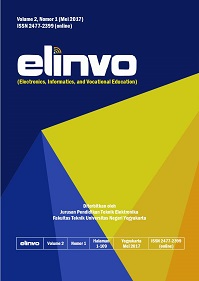Student Competency Association Analysis For Learning Evaluation Using Apriori Algorithm
DOI:
https://doi.org/10.21831/elinvo.v6i2.42264Keywords:
Learning Competencies, Association Rules, AprioriAbstract
References
A. Roskladka, N. Roskladka, G. Kharlamova, and A. Stavytskyy, "The data association algorithm for the formation of optional IT-courses list system," CEUR Workshop Proc., vol. 2732, pp. 515–531, 2020.
C. L. Mao, S. L. Zou, and J. H. Yin, "Educational evaluation based on Apriori-Gen algorithm," Eurasia J. Math. Sci. Technol. Educ., vol. 13, no. 10, pp. 6555–6564, 2017.
J. Jha and L. Ragha, "Educational Data Mining using Improved Apriori Algorithm," Int. J. Inf. Comput. Technol., vol. 3, no. 5, pp. 411–418, 2013.
A. Alinezhad, "Data Mining Apriori Algorithm for Heart Disease Prediction," Int. J. Comput. Commun. Instrum. Eng., vol. 4, no. 1, 2017.
M. Qisman, R. Rosadi, and A. S. Abdullah, "Market basket analysis using apriori algorithm to find consumer patterns in buying goods through transaction data (case study of Mizan computer retail stores)," J. Phys. Conf. Ser., vol. 1722, no. 1, 2021.
J. Silva, N. Varela, L. A. B. López, and R. H. R. Millán, "Association rules extraction for customer segmentation in the SMES sector using the apriori algorithm," Procedia Comput. Sci., vol. 151, no. 2018, pp. 1207–1212, 2019.
S. AlZu'bi, B. Hawashin, M. EIBes, and M. Al-Ayyoub, "A Novel Recommender System Based on Apriori Algorithm for Requirements Engineering," in 2018 Fifth International Conference on Social Networks Analysis, Management and Security (SNAMS), pp. 323–327, 2018.
H. Shih, "Analysis of the Association Rules of Graduates' Employment Types and Achievements in Core Academics using Data Mining at School," The Journal of International Management Studies, vol. 13, no. 2, pp. 8–18, 2018.
Y. I. Abuzawayda, "Mining Postgraduate Students' Data Using Apriori Algorithm," Journal of Computing & Organisational Dynnamics, vol. 1, no. 2, pp. 1–35, 2013.
M. P. Utami, O. D. Nurhayati, and B. Warsito, "Hoax Information Detection System Using Apriori Algorithm and Random Forest Algorithm in Twitter," in 2020 6th International Conference on Interactive Digital Media (ICIDM), pp. 1–5, 2020.
E. D. S. Mulyani et al., "Keyword-Based Hadith Grouping Using Fuzzy C-Means Method," in 2020 2nd International Conference on Cybernetics and Intelligent System (ICORIS), pp. 1–6, 2020.
E. D. S. Mulyani et al., "Implementasi Algoritma K-Means Dan Fp- Growth Untuk Rekomendasi Bimbingan Belajar Berdasarkan Segmentasi Akademik Siswa," IT Journal, vol. 6, no. 2, pp. 160–173, 2018.
A.-M. Karimi-Majd and M. Mahootchi, "A new data mining methodology for generating new service ideas," Inf. Syst. E-bus. Manag., vol. 13, no. 3, pp. 421–443, 2015.
P. C. Tavares, E. F. Gomes, and P. R. Henriques, "Studying programming students motivation using association rules," CSEDU 2018 - Proc. 10th Int. Conf. Comput. Support. Educ., vol. 2, no. Csedu, pp. 514–520, 2018.
I. Djamaludin and A. Nursikuwagus, "Analisis Pola Pembelian Konsumen Pada Transaksi Penjualan Menggunakan Algoritma Apriori," Simetris J. Tek. Mesin, Elektro dan Ilmu Komput., vol. 8, no. 2, p. 671, 2017..
K. Nalavade and B. B. Meshram, "Finding Frequent Itemsets using Apriori Algorihm to Detect Intrusions in Large Dataset," Int. J. Comput. Appl. Inf. Technol. Vol., vol. 6, no. I, pp. 84–92, 2014.
Y. Kurnia, Y. Isharianto, Y. C. Giap, A. Hermawan, and Riki, "Study of application of data mining market basket analysis for knowing sales pattern (association of items) at the O! Fish restaurant using apriori algorithm," J. Phys. Conf. Ser., vol. 1175, no. 1, 2019.
S. Panjaitan et al., "Implementation of Apriori Algorithm for Analysis of Consumer Purchase Patterns," J. Phys. Conf. Ser., vol. 1255, p. 12057, 2019.
M. Tian et al., "Data Dependence Analysis for Defects Data of Relay Protection Devices Based on Apriori Algorithm," IEEE Access, vol. 8, pp. 120647–120653, 2020.
Y. Guo, M. Wang, and X. Li, "Application of an improved Apriori algorithm in a mobile e-commerce recommendation system," Ind. Manag. Data Syst., vol. 117, no. 2, pp. 287–303, 2017.
J. Yang, H. Huang, and X. Jin, "Mining Web Access Sequence with Improved Apriori Algorithm," in 2017 IEEE International Conference on Computational Science and Engineering (CSE) and IEEE International Conference on Embedded and Ubiquitous Computing (EUC), vol. 1, pp. 780–784, 2017.
E. D. S. Mulyani et al., "Analisis Asosiasi Untuk Persediaan Alat-alat Kesehatan Pada Apotek Berkah Ciamis Menggunakan Algoritma Apriori," J. Voice Informatics, vol. 10, No 1, pp. 65–74, 2021.
J. Dongre, G. L. Prajapati, and S. V Tokekar, "The role of Apriori algorithm for finding the association rules in Data mining," in 2014 International Conference on Issues and Challenges in Intelligent Computing Techniques (ICICT), pp. 657–660, 2014.
A. S. Olaniyi et al., "Knowledge Discovery From Educational Database Using Apriori Algorithm," GESJ: Computer Science and Telecommunications, vol. 1, no. 1, pp. 41–51, 2017.
F. Padillo, J. M. Luna, F. Herrera, and S. Ventura, "Mining association rules on Big Data through MapReduce genetic programming," Integr. Comput. Aided. Eng., vol. 25, pp. 31–48, 2018.
Downloads
Published
How to Cite
Issue
Section
Citation Check
License
The article published in ELINVO became ELINVO's right in publication.
This work by ELINVO is licensed under a Creative Commons Attribution-NonCommercial 4.0 International License.









